charging RENAULT SCENIC 2009 J84 / 2.G Engine And Peripherals EDC16 Owner's Guide
[x] Cancel search | Manufacturer: RENAULT, Model Year: 2009, Model line: SCENIC, Model: RENAULT SCENIC 2009 J84 / 2.GPages: 273
Page 153 of 273
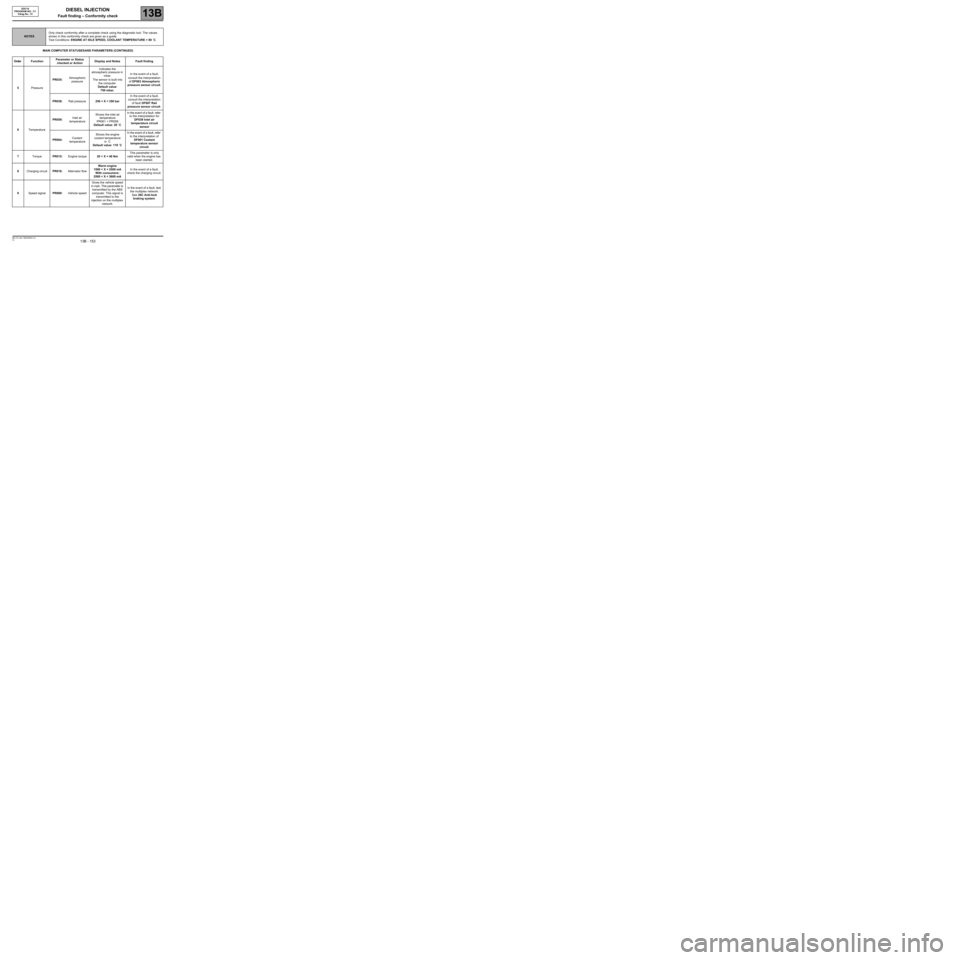
DIESEL INJECTION
Fault finding – Conformity check13B
13B - 153V3 MR-372-J84-13B250$450.mif
EDC16
PROGRAM NO.: C1
Vdiag No.: 51
MAIN COMPUTER STATUSES AND PARAMETERS (CONTINUED)
NOTESOnly check conformity after a complete check using the diagnostic tool. The values
shown in this conformity check are given as a guide.
Test Conditions: ENGINE AT IDLE SPEED, COOLANT TEMPERATURE > 80 ˚C.
Order FunctionParameter or Status
checked or ActionDisplay and Notes Fault finding
5PressurePR035:Atmospheric
pressureIndicates the
atmospheric pressure in
mbar.
The sensor is built into
the computer.
Default value:
750 mbar.In the event of a fault,
consult the interpretation
of DF003 Atmospheric
pressure sensor circuit.
PR038:Rail pressure250 < X < 350 barIn the event of a fault,
consult the interpretation
of fault DF007 Rail
pressure sensor circuit.
6TemperaturePR059:Inlet air
temperatureShows the inlet air
temperature
PR061 = PR059
Default value: 20 ˚CIn the event of a fault, refer
to the interpretation for
DF039 Inlet air
temperature circuit
sensor
PR064:Coolant
temperatureShows the engine
coolant temperature
in ˚C
Default value: 119 ˚CIn the event of a fault, refer
to the interpretation of
DF001 Coolant
temperature sensor
circuit.
7TorquePR015:Engine torque20 < X < 40 NmThis parameter is only
valid when the engine has
been started.
8Charging circuitPR016:Alternator flowWarm engine
1500 < X < 2500 mA
With consumers:
2500 < X < 3600 mAIn the event of a fault,
check the charging circuit.
9Speed signalPR089:Vehicle speedGives the vehicle speed
in mph. This parameter is
transmitted by the ABS
computer. This signal is
transmitted to the
injection on the multiplex
network.In the event of a fault, test
the multiplex network.
See 38C Anti-lock
braking system.
Page 154 of 273
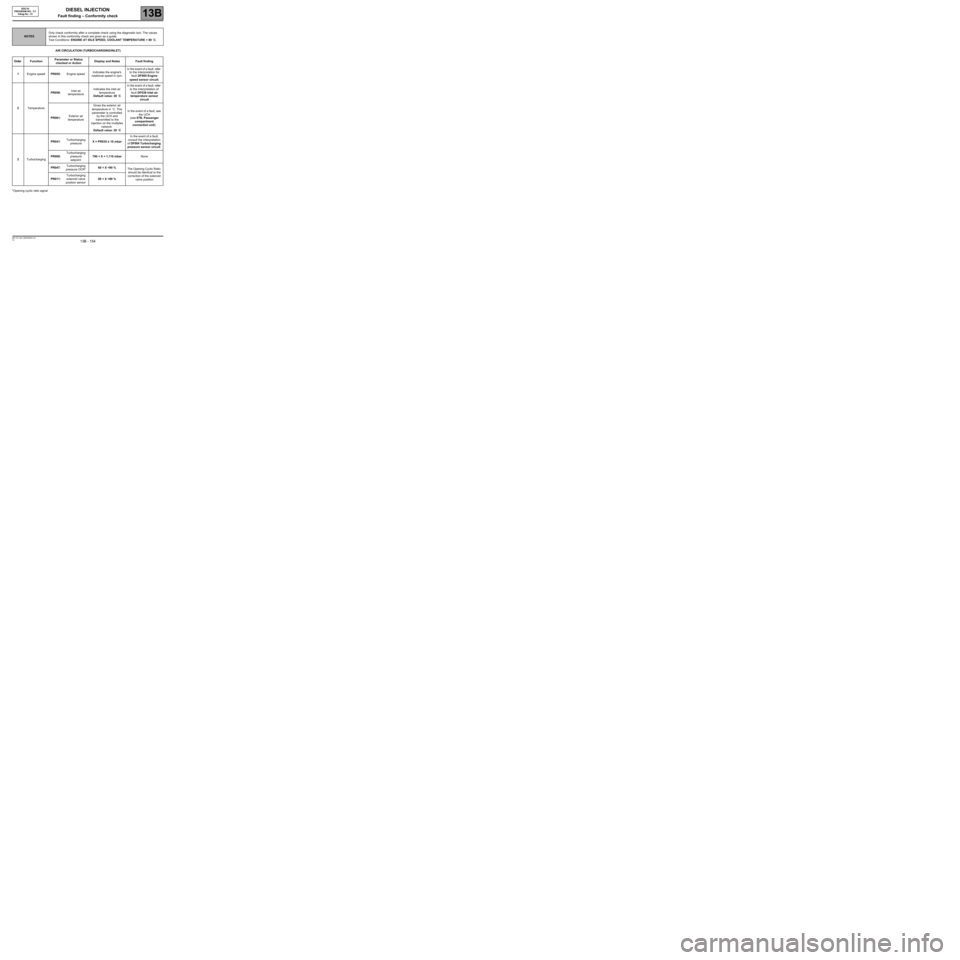
DIESEL INJECTION
Fault finding – Conformity check13B
13B - 154V3 MR-372-J84-13B250$450.mif
EDC16
PROGRAM NO.: C1
Vdiag No.: 51
AIR CIRCULATION (TURBOCHARGING/INLET)
*Opening cyclic ratio signal
NOTESOnly check conformity after a complete check using the diagnostic tool. The values
shown in this conformity check are given as a guide.
Test Conditions: ENGINE AT IDLE SPEED, COOLANT TEMPERATURE > 80 ˚C.
Order FunctionParameter or Status
checked or ActionDisplay and Notes Fault finding
1Engine speedPR055:Engine speedIndicates the engine's
rotational speed in rpm.In the event of a fault, refer
to the interpretation for
fault DF005 Engine
speed sensor circuit.
2TemperaturePR059:Inlet air
temperatureIndicates the inlet air
temperature
Default value: 20 ˚CIn the event of a fault, refer
to the interpretation of
fault DF039 Inlet air
temperature sensor
circuit
PR061:Exterior air
temperatureGives the exterior air
temperature in ˚C. This
parameter is controlled
by the UCH and
transmitted to the
injection on the multiplex
network.
Default value: 20 ˚CIn the event of a fault, see
the UCH
(see 87B, Passenger
compartment
connection unit).
3TurbochargingPR041:Turbocharging
pressureX = PR035 ± 10 mbarIn the event of a fault,
consult the interpretation
of DF004 Turbocharging
pressure sensor circuit.
PR009:Turbocharging
pressure
setpoint790 < X < 1,110 mbarNone
PR047:Turbocharging
pressure OCR*60 < X <90 %
The Opening Cyclic Ratio
should be identical to the
correction of the solenoid
valve position PR011:Turbocharging
solenoid valve
position sensor60 < X <90 %
Page 155 of 273
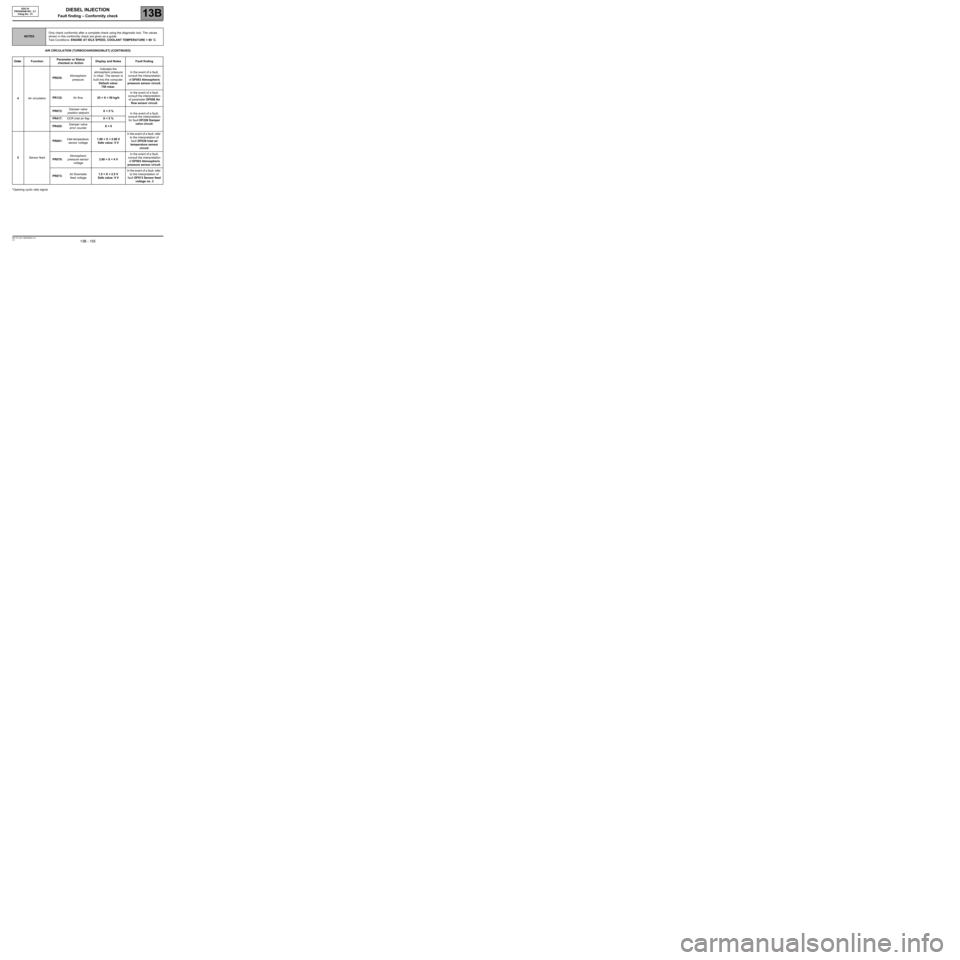
DIESEL INJECTION
Fault finding – Conformity check13B
13B - 155V3 MR-372-J84-13B250$450.mif
EDC16
PROGRAM NO.: C1
Vdiag No.: 51
AIR CIRCULATION (TURBOCHARGING/INLET) (CONTINUED)
*Opening cyclic ratio signal
NOTESOnly check conformity after a complete check using the diagnostic tool. The values
shown in this conformity check are given as a guide.
Test Conditions: ENGINE AT IDLE SPEED, COOLANT TEMPERATURE > 80 ˚C.
Order FunctionParameter or Status
checked or ActionDisplay and Notes Fault finding
4Air circulationPR035:Atmospheric
pressureIndicates the
atmospheric pressure
in mbar. The sensor is
built into the computer.
Default value:
750 mbar.In the event of a fault,
consult the interpretation
of DF003 Atmospheric
pressure sensor circuit.
PR132:Air flow25 < X < 50 kg/hIn the event of a fault,
consult the interpretation
of parameter DF056 Air
flow sensor circuit.
PR672:Damper valve
position setpointX < 5 %
In the event of a fault,
consult the interpretation
for fault DF226 Damper
valve circuit. PR417:OCR inlet air flapX < 5 %
PR420:Damper valve
error counterX = 0
5Sensor feedPR081:Inlet temperature
sensor voltage1.90 < X < 2.90 V
Safe value: 5 VIn the event of a fault, refer
to the interpretation of
fault DF039 Inlet air
temperature sensor
circuit.
PR079:Atmospheric
pressure sensor
voltage3.80 < X < 4 VIn the event of a fault,
consult the interpretation
of DF003 Atmospheric
pressure sensor circuit.
PR073:Air flowmeter
feed voltage1.5 < X < 2.5 V
Safe value: 0 VIn the event of a fault, refer
to the interpretation of
fault DF013 Sensor feed
voltage no. 3
Page 169 of 273
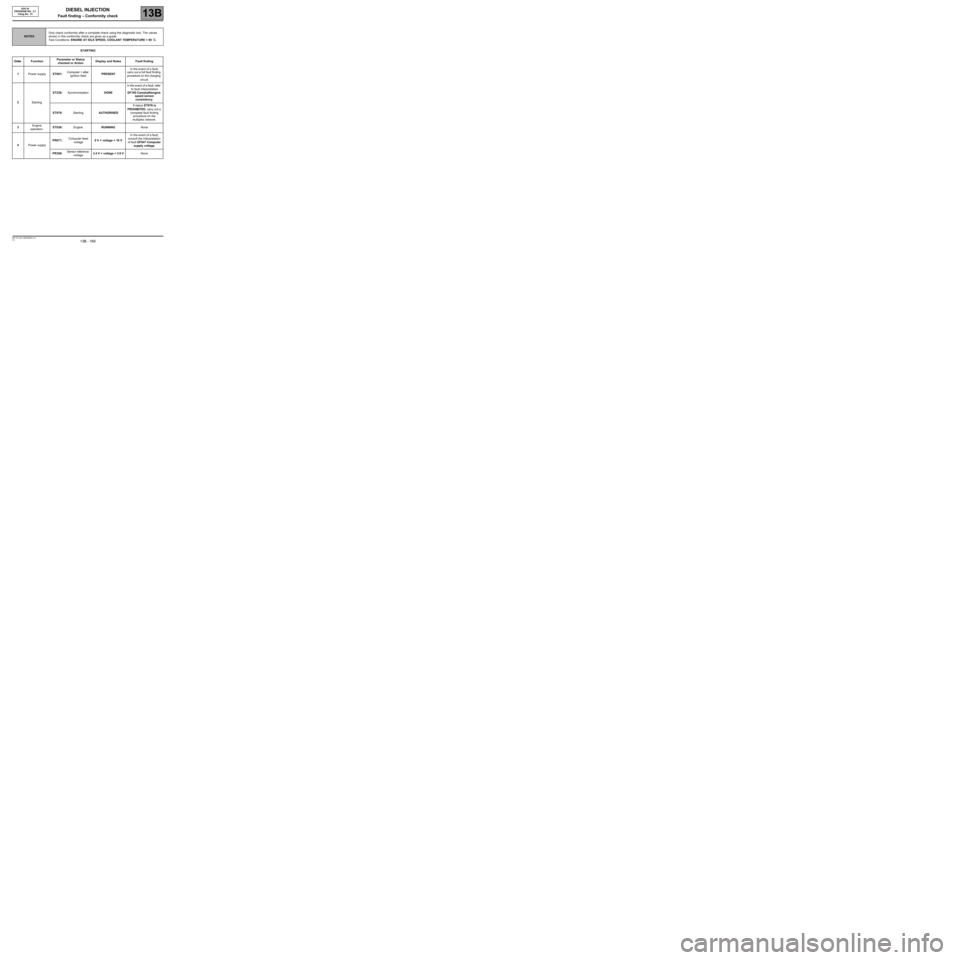
DIESEL INJECTION
Fault finding – Conformity check13B
13B - 169V3 MR-372-J84-13B250$540.mif
EDC16
PROGRAM NO.: C1
Vdiag No.: 51
STARTING
NOTESOnly check conformity after a complete check using the diagnostic tool. The values
shown in this conformity check are given as a guide.
Test Conditions: ENGINE AT IDLE SPEED, COOLANT TEMPERATURE > 80 ˚C.
Order FunctionParameter or Status
checked or ActionDisplay and Notes Fault finding
1Power supplyET001:Computer + after
ignition feedPRESENTIn the event of a fault,
carry out a full fault finding
procedure on the charging
circuit.
2StartingET238:SynchronisationDONEIn the event of a fault, refer
to fault interpretation
DF195 Camshaft/engine
speed sensor
consistency.
ET076:StartingAUTHORISEDIf status ET076 is
PROHIBITED, carry out a
complete fault finding
procedure on the
multiplex network.
3Engine
operation.ET038:EngineRUNNINGNone
4Power supplyPR071:Computer feed
voltage9 V < voltage < 16 VIn the event of a fault,
consult the interpretation
of fault DF047 Computer
supply voltage.
PR358:Sensor reference
voltage3.4 V < voltage < 3.8 VNone
Page 206 of 273

DIESEL INJECTION
Fault finding – Parameter summary table13B
13B - 206V3 MR-372-J84-13B250$675.mif
EDC16
PROGRAM NO.: C1
Vdiag No.: 51DIESEL INJECTION
Fault finding – Parameter summary table
OCR*: opening cyclic ratioTool parameter Diagnostic tool title
PR005EGR valve opening setpoint
PR006Rail pressure regulator current
PR007Rail pressure regulator current setpoint
PR008Rail pressure setpoint
PR009Turbocharging pressure setpoint
PR011Turbocharging solenoid valve position correction
PR015Engine torque
PR016Alternator flow
PR017Fuel flow
PR022EGR valve position feedback loop difference
PR030Accelerator pedal position
PR035Atmospheric pressure
PR037Refrigerant pressure
PR038Rail pressure
PR041Turbocharging pressure
PR047Turbocharging pressure OCR*
PR048OCR* rail pressure regulation valve
PR051EGR valve position feedback
PR053Speed requested by air conditioning
PR055Engine speed
PR059Inlet air temperature
PR061Exterior air temperature
PR064Coolant temperature
PR071Computer feed voltage
PR073Air flowmeter feed voltage
PR076Refrigerant sensor voltage
PR077EGR valve position sensor voltage
MR-372-J84-13B250$675.mif
Page 208 of 273
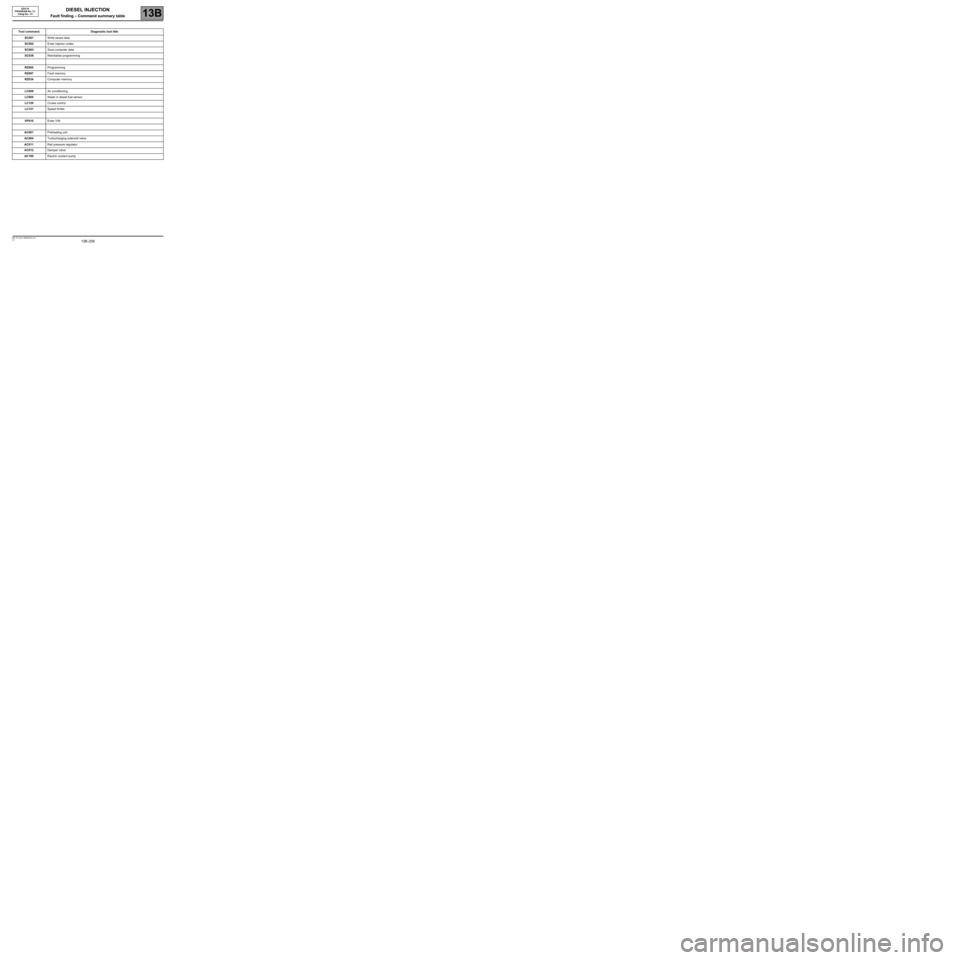
DIESEL INJECTION
Fault finding – Command summary table13B
13B -208V3 MR-372-J84-13B250$720.mif
EDC16
PROGRAM No: C1
Vdiag No.: 51DIESEL INJECTION
Fault finding – Command summary table
Tool command Diagnostic tool title
SC001Write saved data
SC002Enter injector codes
SC003Save computer data
SC036Reinitialise programming
RZ005Programming
RZ007Fault memory
RZ034Computer memory
LC009Air conditioning
LC065Water in diesel fuel sensor
LC120Cruise control
LC121Speed limiter
VP010Enter VIN
AC001Preheating unit
AC004Turbocharging solenoid valve
AC011Rail pressure regulator
AC012Damper valve
AC195Electric coolant pump
Page 216 of 273
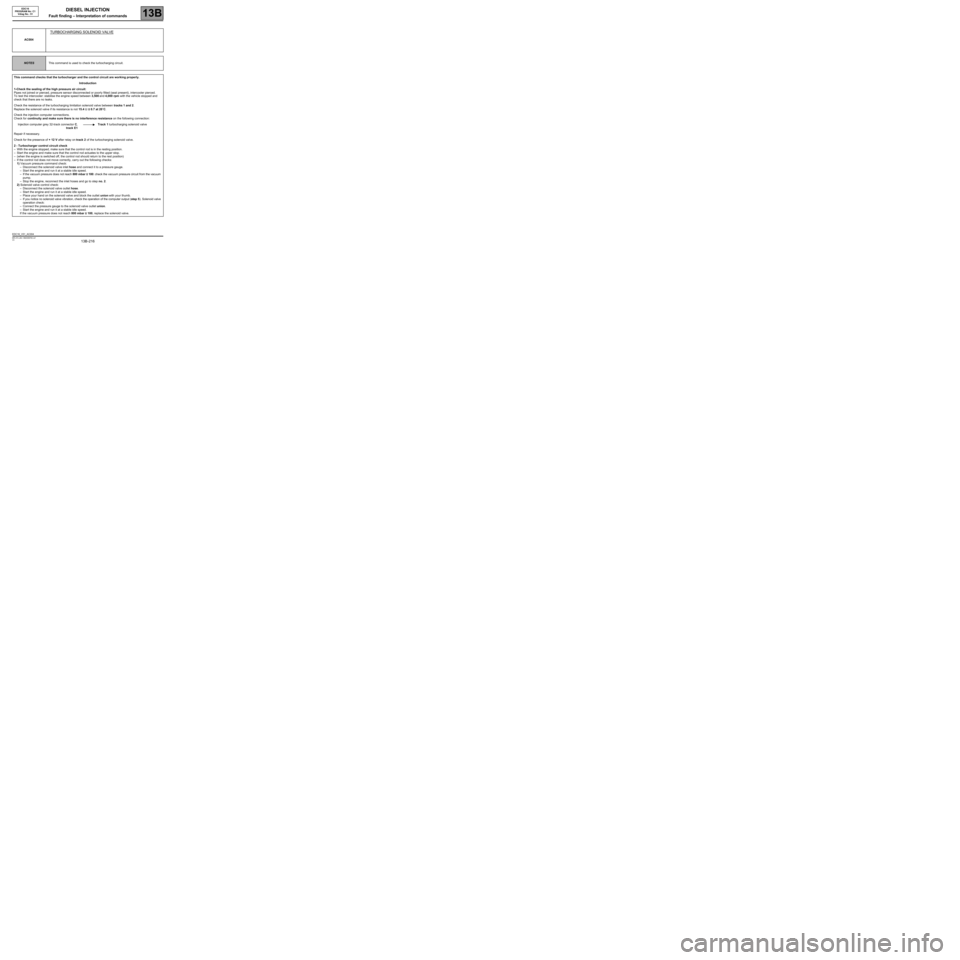
DIESEL INJECTION
Fault finding – Interpretation of commands13B
13B -216V3 MR-372-J84-13B250$765.mif
EDC16
PROGRAM No: C1
Vdiag No.: 51
AC004
TURBOCHARGING SOLENOID VALVE
NOTESThis command is used to check the turbocharging circuit.
This command checks that the turbocharger and the control circuit are working properly.
Introduction
1-Check the sealing of the high pressure air circuit:
Pipes not joined or pierced, pressure sensor disconnected or poorly fitted (seal present), intercooler pierced.
To test the intercooler: stabilise the engine speed between 3,500 and 4,000 rpm with the vehicle stopped and
check that there are no leaks.
Check the resistance of the turbocharging limitation solenoid valve between tracks 1 and 2.
Replace the solenoid valve if its resistance is not 15.4 Ω ± 0.7 at 20˚C.
Check the injection computer connections.
Check for continuity and make sure there is no interference resistance on the following connection:
Injection computer grey 32-track connector C,
track E1Track 1 turbocharging solenoid valve
Repair if necessary.
Check for the presence of + 12 V after relay on track 2 of the turbocharging solenoid valve.
2 - Turbocharger control circuit check
–With the engine stopped, make sure that the control rod is in the resting position.
–Start the engine and make sure that the control rod actuates to the upper stop.
–(when the engine is switched off, the control rod should return to the rest position)
–If the control rod does not move correctly, carry out the following checks:
1) Vacuum pressure command check:
–Disconnect the solenoid valve inlet hose and connect it to a pressure gauge.
–Start the engine and run it at a stable idle speed.
–If the vacuum pressure does not reach 800 mbar ± 100: check the vacuum pressure circuit from the vacuum
pump.
–Stop the engine, reconnect the inlet hoses and go to step no. 2.
2) Solenoid valve control check:
–Disconnect the solenoid valve outlet hose.
–Start the engine and run it at a stable idle speed.
–Place your hand on the solenoid valve and block the outlet union with your thumb.
–If you notice no solenoid valve vibration, check the operation of the computer output (step 5). Solenoid valve
operation check:
–Connect the pressure gauge to the solenoid valve outlet union.
–Start the engine and run it at a stable idle speed.
If the vacuum pressure does not reach 800 mbar ± 100, replace the solenoid valve.
EDC16_V51_AC004
Page 217 of 273
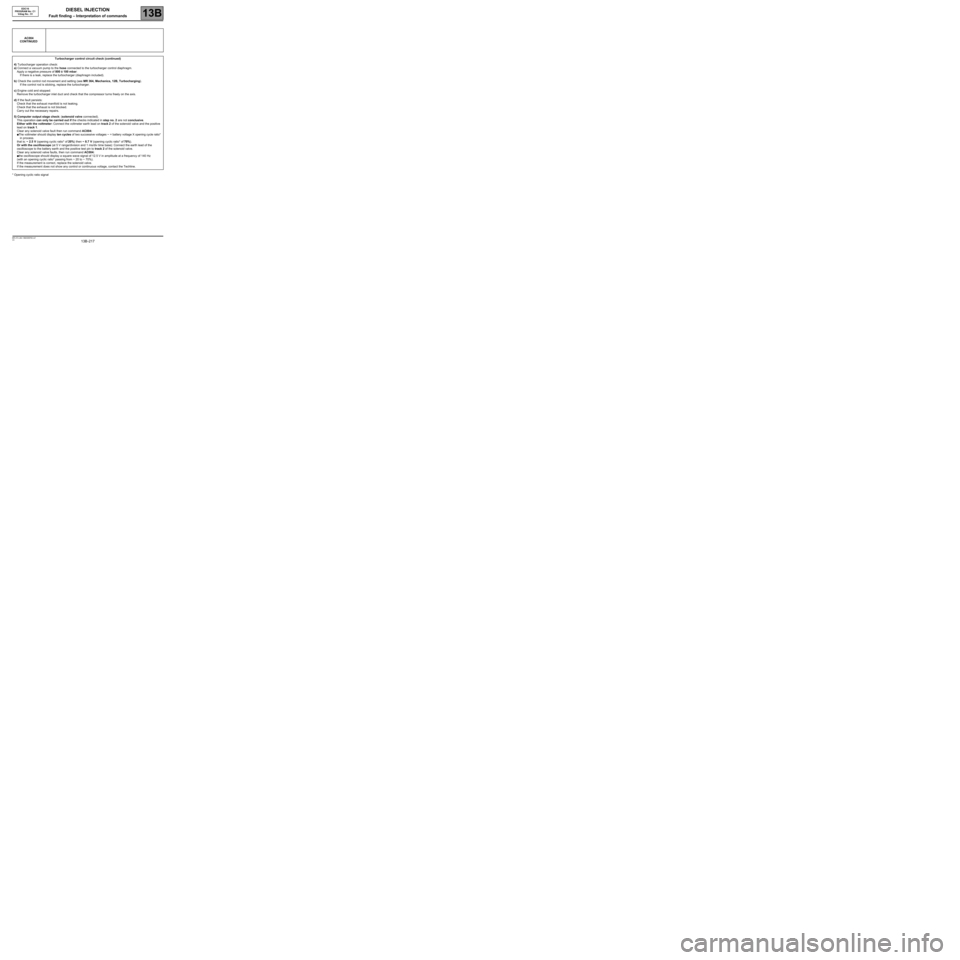
DIESEL INJECTION
Fault finding – Interpretation of commands13B
13B -217V3 MR-372-J84-13B250$765.mif
EDC16
PROGRAM No: C1
Vdiag No.: 51
* Opening cyclic ratio signalAC004
CONTINUED
Turbocharger control circuit check (continued)
4) Turbocharger operation check:
a) Connect a vacuum pump to the hose connected to the turbocharger control diaphragm.
Apply a negative pressure of 800 ± 100 mbar:
If there is a leak, replace the turbocharger (diaphragm included).
b) Check the control rod movement and setting (see MR 364, Mechanics, 12B, Turbocharging).
If the control rod is sticking, replace the turbocharger.
c) Engine cold and stopped:
Remove the turbocharger inlet duct and check that the compressor turns freely on the axis.
d) If the fault persists:
Check that the exhaust manifold is not leaking.
Check that the exhaust is not blocked.
Carry out the necessary repairs.
5) Computer output stage check: (solenoid valve connected).
This operation can only be carried out if the checks indicated in step no. 2 are not conclusive.
Either with the voltmeter: Connect the voltmeter earth lead on track 2 of the solenoid valve and the positive
lead on track 1.
Clear any solenoid valve fault then run command AC004:
●The voltmeter should display ten cycles of two successive voltages ~ = battery voltage X opening cycle ratio*
in process.
that is: ~ 2.5 V (opening cyclic ratio* of 20%) then ~ 8.7 V (opening cyclic ratio* of 70%).
Or with the oscilloscope (at 5 V range/division and 1 ms/div time base): Connect the earth lead of the
oscilloscope to the battery earth and the positive test pin to track 2 of the solenoid valve.
Clear any solenoid valve faults, then run command AC004:
●the oscilloscope should display a square wave signal of 12.5 V in amplitude at a frequency of 140 Hz
(with an opening cyclic ratio* passing from ~ 20 to ~ 70%).
If the measurement is correct, replace the solenoid valve.
If the measurement does not show any control or continuous voltage, contact the Techline.
Page 224 of 273
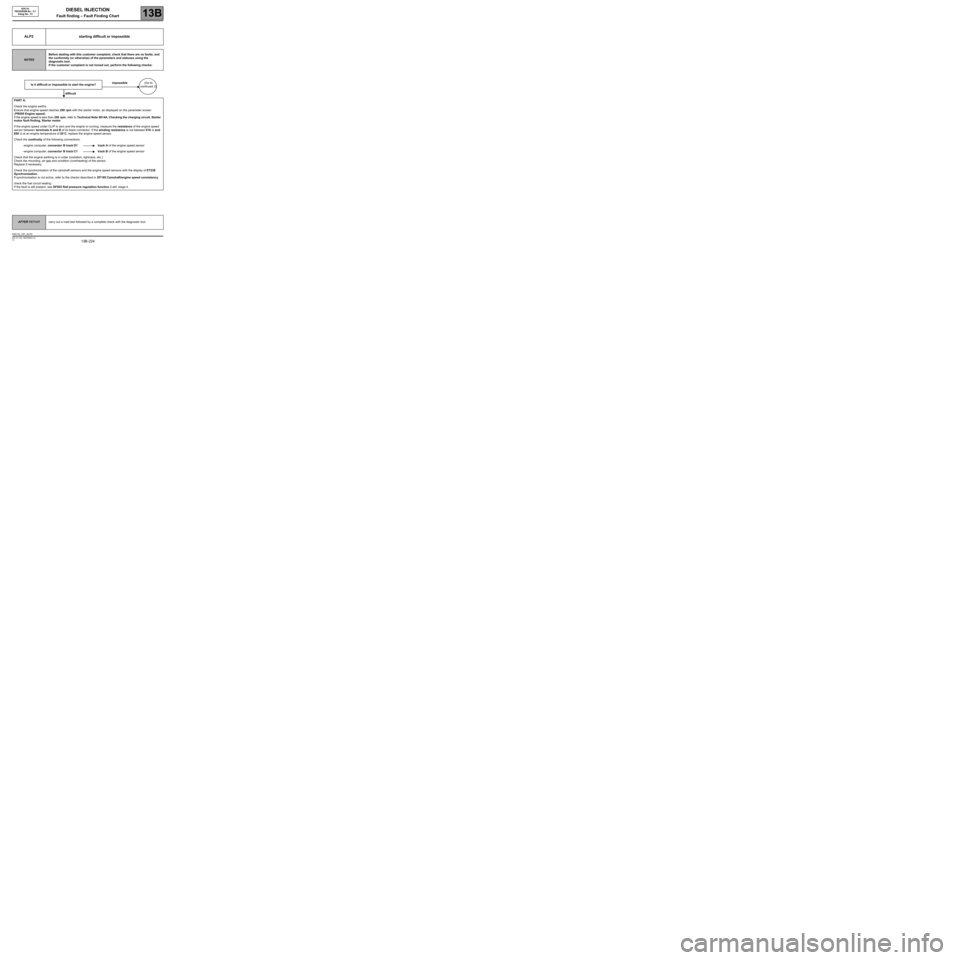
DIESEL INJECTION
Fault finding – Fault Finding Chart13B
13B -224V3 MR-372-J84-13B250$855.mif
EDC16
PROGRAM No.: C1
Vdiag No.: 51
ALP2 starting difficult or impossible
NOTESBefore dealing with this customer complaint, check that there are no faults, and
the conformity (or otherwise) of the parameters and statuses using the
diagnostic tool.
If the customer complaint is not ironed out, perform the following checks:
Is it difficult or impossible to start the engine?impossible(Go to
continued 2)
difficult
PART A:
Check the engine earths.
Ensure that engine speed reaches 250 rpm with the starter motor, as displayed on the parameter screen
(PR055 Engine speed).
If the engine speed is less than 250 rpm, refer to Technical Note 6014A, Checking the charging circuit, Starter
motor fault finding, Starter motor.
If the engine speed under CLIP is zero and the engine is running, measure the resistance of the engine speed
sensor between terminals A and B of its black connector. If the winding resistance is not between 510 Ω and
850 Ω at an engine temperature of 20˚C, replace the engine speed sensor.
Check the continuity of the following connections:
–engine computer, connector B track D1 track A of the engine speed sensor
–engine computer, connector B track C1 track B of the engine speed sensor
Check that the engine earthing is in order (oxidation, tightness, etc.).
Check the mounting, air gap and condition (overheating) of the sensor.
Replace if necessary.
Check the synchronisation of the camshaft sensors and the engine speed sensors with the display of ET238
Synchronisation.
If synchronisation is not active, refer to the checks described in DF195 Camshaft/engine speed consistency.
check the fuel circuit sealing.
If the fault is still present, see DF053 Rail pressure regulation function 2.def, stage 4.
AFTER REPAIRcarry out a road test followed by a complete check with the diagnostic tool.
EDC16_V51_ALP2
Page 226 of 273
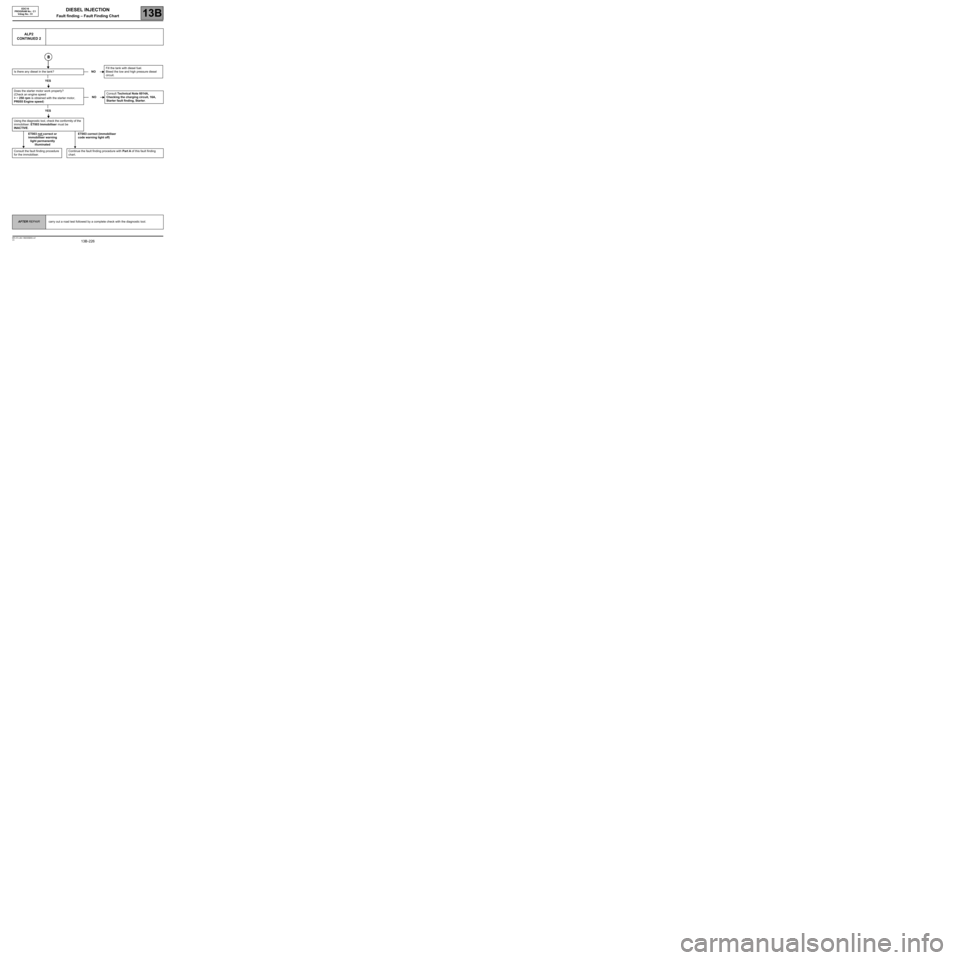
DIESEL INJECTION
Fault finding – Fault Finding Chart13B
13B -226V3 MR-372-J84-13B250$855.mif
EDC16
PROGRAM No.: C1
Vdiag No.: 51
ALP2
CONTINUED 2
Is there any diesel in the tank?
YES
Does the starter motor work properly?
(Check an engine speed
> ~ 250 rpm is obtained with the starter motor,
PR055 Engine speed)
YES
Using the diagnostic tool, check the conformity of the
immobiliser: ET003 Immobiliser must be
INACTIVE.
ET003 not
correct or
immobiliser warning
light permanently
illuminatedET003 correct (immobiliser
code warning light off)
Consult the fault finding procedure
for the immobiliser.
NOFill the tank with diesel fuel.
Bleed the low and high pressure diesel
circuit.
NOConsult Technical Note 6014A,
Checking the charging circuit, 16A,
Starter fault finding, Starter.
Continue the fault finding procedure with Part A of this fault finding
chart.
AFTER REPAIRcarry out a road test followed by a complete check with the diagnostic tool.